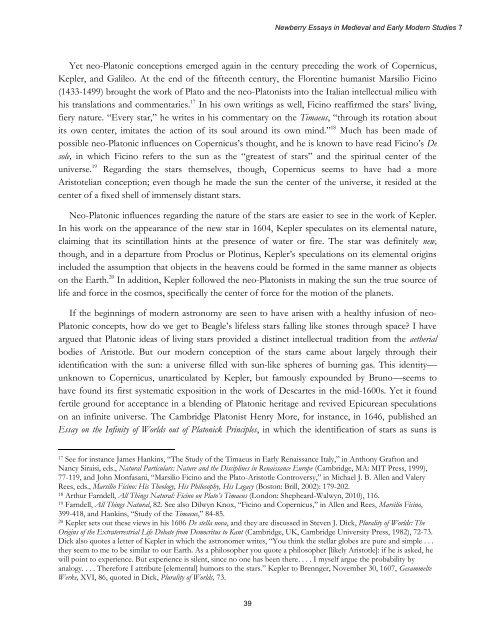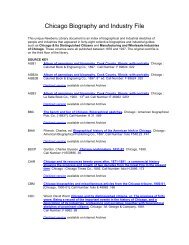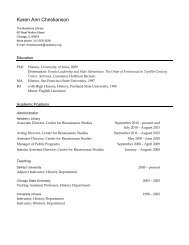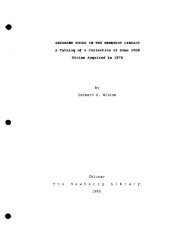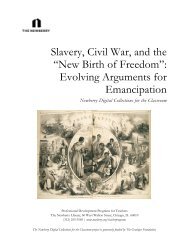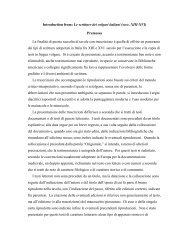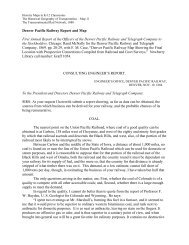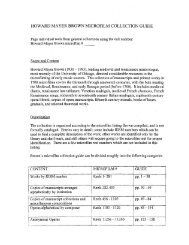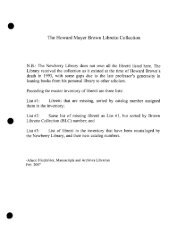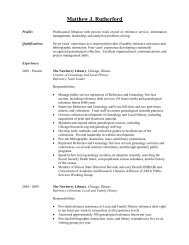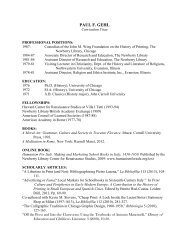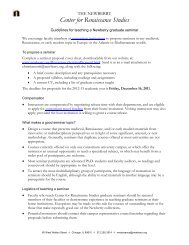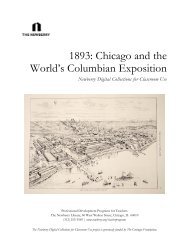Newberry Essays in Medieval and Early Modern ... - Newberry Library
Newberry Essays in Medieval and Early Modern ... - Newberry Library
Newberry Essays in Medieval and Early Modern ... - Newberry Library
Create successful ePaper yourself
Turn your PDF publications into a flip-book with our unique Google optimized e-Paper software.
<strong>Newberry</strong> <strong>Essays</strong> <strong>in</strong> <strong>Medieval</strong> <strong>and</strong> <strong>Early</strong> <strong>Modern</strong> Studies 7Yet neo-Platonic conceptions emerged aga<strong>in</strong> <strong>in</strong> the century preced<strong>in</strong>g the work of Copernicus,Kepler, <strong>and</strong> Galileo. At the end of the fifteenth century, the Florent<strong>in</strong>e humanist Marsilio Fic<strong>in</strong>o(1433-1499) brought the work of Plato <strong>and</strong> the neo-Platonists <strong>in</strong>to the Italian <strong>in</strong>tellectual milieu withhis translations <strong>and</strong> commentaries. 17 In his own writ<strong>in</strong>gs as well, Fic<strong>in</strong>o reaffirmed the stars’ liv<strong>in</strong>g,fiery nature. ―Every star,‖ he writes <strong>in</strong> his commentary on the Timaeus, ―through its rotation aboutits own center, imitates the action of its soul around its own m<strong>in</strong>d.‖ 18 Much has been made ofpossible neo-Platonic <strong>in</strong>fluences on Copernicus’s thought, <strong>and</strong> he is known to have read Fic<strong>in</strong>o’s Desole, <strong>in</strong> which Fic<strong>in</strong>o refers to the sun as the ―greatest of stars‖ <strong>and</strong> the spiritual center of theuniverse. 19 Regard<strong>in</strong>g the stars themselves, though, Copernicus seems to have had a moreAristotelian conception; even though he made the sun the center of the universe, it resided at thecenter of a fixed shell of immensely distant stars.Neo-Platonic <strong>in</strong>fluences regard<strong>in</strong>g the nature of the stars are easier to see <strong>in</strong> the work of Kepler.In his work on the appearance of the new star <strong>in</strong> 1604, Kepler speculates on its elemental nature,claim<strong>in</strong>g that its sc<strong>in</strong>tillation h<strong>in</strong>ts at the presence of water or fire. The star was def<strong>in</strong>itely new,though, <strong>and</strong> <strong>in</strong> a departure from Proclus or Plot<strong>in</strong>us, Kepler’s speculations on its elemental orig<strong>in</strong>s<strong>in</strong>cluded the assumption that objects <strong>in</strong> the heavens could be formed <strong>in</strong> the same manner as objectson the Earth. 20 In addition, Kepler followed the neo-Platonists <strong>in</strong> mak<strong>in</strong>g the sun the true source oflife <strong>and</strong> force <strong>in</strong> the cosmos, specifically the center of force for the motion of the planets.If the beg<strong>in</strong>n<strong>in</strong>gs of modern astronomy are seen to have arisen with a healthy <strong>in</strong>fusion of neo-Platonic concepts, how do we get to Beagle’s lifeless stars fall<strong>in</strong>g like stones through space? I haveargued that Platonic ideas of liv<strong>in</strong>g stars provided a dist<strong>in</strong>ct <strong>in</strong>tellectual tradition from the aetherialbodies of Aristotle. But our modern conception of the stars came about largely through theiridentification with the sun: a universe filled with sun-like spheres of burn<strong>in</strong>g gas. This identity—unknown to Copernicus, unarticulated by Kepler, but famously expounded by Bruno—seems tohave found its first systematic exposition <strong>in</strong> the work of Descartes <strong>in</strong> the mid-1600s. Yet it foundfertile ground for acceptance <strong>in</strong> a blend<strong>in</strong>g of Platonic heritage <strong>and</strong> revived Epicurean speculationson an <strong>in</strong>f<strong>in</strong>ite universe. The Cambridge Platonist Henry More, for <strong>in</strong>stance, <strong>in</strong> 1646, published anEssay on the Inf<strong>in</strong>ity of Worlds out of Platonick Pr<strong>in</strong>ciples, <strong>in</strong> which the identification of stars as suns is17 See for <strong>in</strong>stance James Hank<strong>in</strong>s, ―The Study of the Timaeus <strong>in</strong> <strong>Early</strong> Renaissance Italy,‖ <strong>in</strong> Anthony Grafton <strong>and</strong>Nancy Siraisi, eds., Natural Particulars: Nature <strong>and</strong> the Discipl<strong>in</strong>es <strong>in</strong> Renaissance Europe (Cambridge, MA: MIT Press, 1999),77-119, <strong>and</strong> John Monfasani, ―Marsilio Fic<strong>in</strong>o <strong>and</strong> the Plato-Aristotle Controversy,‖ <strong>in</strong> Michael J. B. Allen <strong>and</strong> ValeryRees, eds., Marsilio Fic<strong>in</strong>o: His Theology, His Philosophy, His Legacy (Boston: Brill, 2002): 179-202.18 Arthur Farndell, All Th<strong>in</strong>gs Natural: Fic<strong>in</strong>o on Plato’s Timaeus (London: Shepheard-Walwyn, 2010), 116.19 Farndell, All Th<strong>in</strong>gs Natural, 82. See also Dilwyn Knox, ―Fic<strong>in</strong>o <strong>and</strong> Copernicus,‖ <strong>in</strong> Allen <strong>and</strong> Rees, Marsilio Fic<strong>in</strong>o,399-418, <strong>and</strong> Hank<strong>in</strong>s, ―Study of the Timaeus,‖ 84-85.20 Kepler sets out these views <strong>in</strong> his 1606 De stella nova, <strong>and</strong> they are discussed <strong>in</strong> Steven J. Dick, Plurality of Worlds: TheOrig<strong>in</strong>s of the Extraterrestrial Life Debate from Democritus to Kant (Cambridge, UK, Cambridge University Press, 1982), 72-73.Dick also quotes a letter of Kepler <strong>in</strong> which the astronomer writes, ―You th<strong>in</strong>k the stellar globes are pure <strong>and</strong> simple . . .they seem to me to be similar to our Earth. As a philosopher you quote a philosopher [likely Aristotle]: if he is asked, hewill po<strong>in</strong>t to experience. But experience is silent, s<strong>in</strong>ce no one has been there. . . . I myself argue the probability byanalogy. . . . Therefore I attribute [elemental] humors to the stars.‖ Kepler to Brennger, November 30, 1607, GesammelteWerke, XVI, 86, quoted <strong>in</strong> Dick, Plurality of Worlds, 73.39


